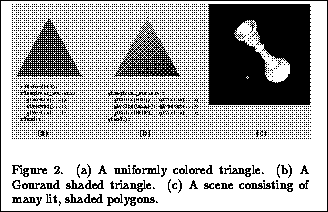In OpenGL, most geometric objects are
drawn by enclosing a series of coordinate sets that
specify vertices and optionally normals,
texture coordinates,
and colors between glBegin/glEnd command pairs.
For example, to specify a triangle with vertices at
,
, and
, one could write:
glBegin(GL_POLYGON); glVertex3i(0,0,0); glVertex3i(0,1,0); glVertex3i(1,0,1); glEnd();
Each vertex may be specified with two, three, or four coordinates (four coordinates indicate a homogeneous three-dimensional location). In addition, a current normal, current texture coordinates, and current color may be used in processing each vertex. OpenGL uses normals in lighting calculations; the current normal is a three-dimensional vector that may be set by sending three coordinates that specify it. Color may consist of either red, green, blue, and alpha values (when OpenGL has been initialized to RGBA mode) or a single color index value (when initialization specified color index mode). One, two, three, or four texture coordinates determine how a texture image maps onto a primitive.
Each of the commands that specify vertex coordinates, normals, colors, or texture coordinates comes in several flavors to accomodate differing application's data formats and numbers of coordinates. Data may also be passed to these commands either as an argument list or as a pointer to a block of storage containing the data. The variants are distinguished by mnemonic suffixes.
Using a procedure call to specify each individual group of data that together
define a primitive means that an application may store data in any format and
order that it chooses;
data need not be stored in a form convenient for presentation to the graphics
API because OpenGL accomodates almost any data type and format using the
appropriate combination of data specification procedures.
Another advantage of this scheme is that by simply combining calls in
the appropriate order, different effects may be achieved.
Figure 2 shows an example of a uniformly colored triangle
obtained by specifying a single color that is inherited by all vertices of
the triangle;
a smooth shaded triangle is obtained by respecifying a color
before each vertex.
Not every possible data format is supported
(byte values may not be given for vertex coordinates, for instance) only
because it was found from experience with IRIS GL that not all formats are
used.
Adding the missing formats in the future, however,
would be a trivial undertaking.

One disadvantage of using procedure calls on such a fine grain is that it may result in poor performance if procedure calls are costly. In such a situation an interface that specifies a format for a block of data that is sent all at once may have a performance advantage. The difficulty with specifying a block of data, however, is that it either constrains the application to store its data in one of the supported formats, or it requires the application to copy its data into a block structured in one of those formats, resulting in inefficiency. (Allowing any format arising from an arbitrary combination of individual data types is impractical because there are so many combinations.)
In OpenGL, the maximum flexibility provided by individual procedure calls was deemed more important than any inefficiency induced by using those calls. This decision is partly driven by the consideration that modern compilers and computer hardware have improved to the point where procedure calls are usually relatively inexpensive, especially when compared with the work necessary to process the geometric data contained in the call. This is one area in which OpenGL differs significantly from PEX; with PEX, a primitive's vertices (and associated data) are generally presented all at once in a single array. If it turns out that fine-grained procedure calls are too expensive, then it may be necessary to add a few popular block formats to the OpenGL API or to provide a mechanism for defining such formats.